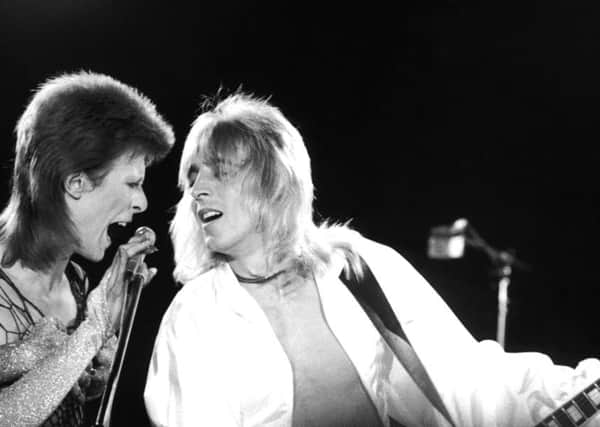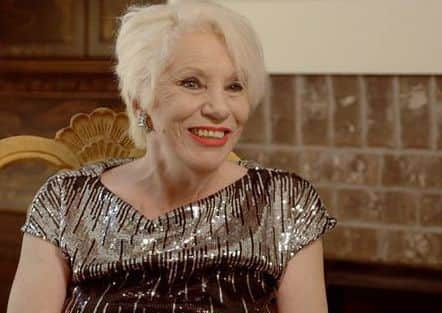Angie Bowie on Hull's Mick Ronson - the starman's sidekick


It was a simple gesture but one which has been etched in rock folklore ever since David Bowie wrapped a comradely arm around the shoulder of guitarist Mick Ronson while they were performing Starman on Top Of The Pops in July 1972.
For some it was the start of a social revolution – happening just weeks after Bowie announced to Melody Maker “I’m gay and always have been” – but for Angie Bowie, the Cypriot-American who was married to the singer between 1970 and 1980, the accompanying fuss still seems absurd.
Advertisement
Hide AdAdvertisement
Hide Ad“I’d never heard such a load of b******s,” she says forcefully as we discuss Beside Bowie, a new documentary for Sky Arts that shines a light on the life of Hull-born guitar slinger Ronson and his contribution to the Spiders From Mars, the band indelibly linked to a string of classic Bowie albums from the early 1970s.


“You don’t put your arm around the shoulders of a musician you’re playing with when you’re doing a chorus or you’re getting him to start playing a solo. I’ve been an entertainer and a performer myself, I’ve done it a thousand times. I suppose it’s not looked at that much because I’m a girl and people in my band were boys but I suppose if I’d had a girl drummer and done it that would have been a moment of high excitement. It’s rubbish.”
Angie, now aged 67, recollects her first meeting with Ronson well. It was February 1970 and David Bowie was then looking for a new lead guitarist to join his band, who were at that point called The Hype. Ronson, then 23 years old, was suggested by drummer John Cambridge, who had known him from their time in the East Yorkshire music scene.
“He was as charming as he could be. We went up to Hull to meet him and he was fabulous, very friendly, very nice and it was quite apparent very quickly how competent he was and what a skilled musician he was.”
Advertisement
Hide AdAdvertisement
Hide AdTwo days later Ronson made his debut at Bowie’s side during an In Concert broadcast on BBC Radio 1. Angie noticed the pair got on immediately as Ronson moved into Haddon Hall, the sprawling Victorian villa in Beckenham where they were all then living.


“David was a very easy to get along with person for other musicians. He was very outgoing and explained exactly what he wanted. Ronno was very good and very bright so I don’t think there were any communication problems whatsoever.”
Angie has been credited with encouraging Bowie and his band – who soon included two more Yorkshiremen, Trevor Bolder and Mick ‘Woody’ Woodmansey – to dress more flamboyantly.
“Do you mean was I sergeant in command?” she says, laughing at the idea. “No, I told them if they even thought about going out like a bunch of American rock ’n’ rollers in dirty jeans and T-shirts they could forget about it because we’d be going nowhere.”
Advertisement
Hide AdAdvertisement
Hide AdStill, it’s been suggested there was some resistance from the down-to-earth working-class Ronson, Bolder and Woodmansey. “They didn’t wear anything right away, it evolved,” says Angie. She got designer Freddie Burretti on board who helped shape the band’s look. “I said to them, ‘Look, we’re going to have to polish this up a bit, you’re going to have to realise you’re entertainers now, you’re not just musicians’. You’ve got to wear make-up and you’ve got to get your hair looking great. You’ve got to make a few changes so you look more dynamic on stage so that way it’s easier for kids to spot you and pull out the person, whoever it is, on stage that appeals to them most’.
“I said the individuality part of it is totally there, it’s just the teamwork of a band – which means having outfits that are not necessarily the same but in the same style, it gives it a theme and makes it easier for people to relate to. Of course in our case it was easier for kids to copy and that’s where interactive entertainment and fan interest works best, I felt – if they allow their imaginations to run so wild that they will sit down and make themselves an outfit that looks like whoever’s on stage and a lot of kids did. Part of the excitement, I think, was the interaction with the audience.”
In the documentary Angie describes Ronson as “much more than a lead guitarist”. Certainly his contribution as an arranger was a key contributory factor to the success of records such as Hunky Dory, The Rise and Fall of Ziggy Stardust and the Spiders From Mars and Aladdin Sane as well as Lou Reed’s Transformer.
Angie disputes the idea that Ronson’s work was overlooked, at least by those in the know. “Media or the critics might have overlooked him. The audiences loved him,” she says.
Advertisement
Hide AdAdvertisement
Hide AdAmid all the hysteria surrounding Ziggy Stardust, Ronson was to meet his own future wife when Angie brought in Suzi Fussey to style Bowie’s famous red feather cut hairdo. The cut itself, Angie says, was modelled on an image in Vogue magazine. “We just changed the colour and made it look more like a puffball, so it looked like a dandelion.”
It was while the Ziggy tour was blazing across the US and Japan in 1972 that some cracks started to appear in the band when Woodmansey and Bolder discovered American piano player Mike Garson was being paid considerably more than their £50 a week and challenged Bowie’s manager Tony Defries. The following year, on stage at the Hammersmith Odeon, Bowie stunned fans by announcing the end of the band.
Ronson had secretly known about the plan – with Defries promising to launch the guitarist as a solo artist – yet it seems to have come as a shock to Bolder, Woodmansey and Angie Bowie. “I was not aware at all and I was extremely miffed,” she says. “It did come like a bolt from the blue. The band and I were gobsmacked. I got very angry with David and Tony Defries subsequently.”
Ronson’s career after the Spiders was not without its musical highs – three solo albums, a long-running partnership with Ian Hunter of Mott The Hoople, a spell in Bob Dylan’s Rolling Thunder Revue – but, as the documentary makes clear, he rarely seemed to get his financial due and as he battled liver cancer in 1992 it was to be production work on Morrissey’s album Your Arsenal that helped provide much-needed funds. He died on April 29, 1993 aged 43, leaving behind his wife Suzi, daughter Lisa and two sons, Nicholas and Joakim.
Advertisement
Hide AdAdvertisement
Hide AdAngie feels Ronson could perhaps have gone on to be a bigger star. “[His career] needed someone like me to organise it, to be quite honest, and to help him,” she says.
“I hoped it was going to be more successful – and the music was, it was just as far as touring was concerned he didn’t have enough hits at the time to warrant a tour subsidy that would have allowed him to do something really imaginative.”
Beside Bowie: The Mick Ronson Story is due to be shown on Sky Arts on May 27. www.sky.com/watch/channel/sky-arts/beside-bowie
Hull City of Culture is due to celebrate Mick Ronson’s roots in the city in Turn and Face The Strange, a multi-media show which is being staged at the Freedom Centre in Hull from August 15-19.
Advertisement
Hide AdAdvertisement
Hide AdAssembled by Hull writers and theatre makers Garry Burnett and Rupert Creed, it aims to “dig a little deeper to uncover the untold tale of how a working-class boy from Greatfield Estate challenged social norms to champion a new music and social culture”.
Featuring memories of friends, fans and fellow musicians, personal photographs and archive film, as well as music from a live band, the show will be accompanied by a major exhibition.
For more details visit www.hull2017.co.uk